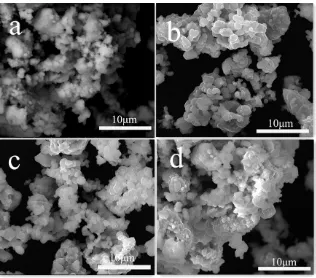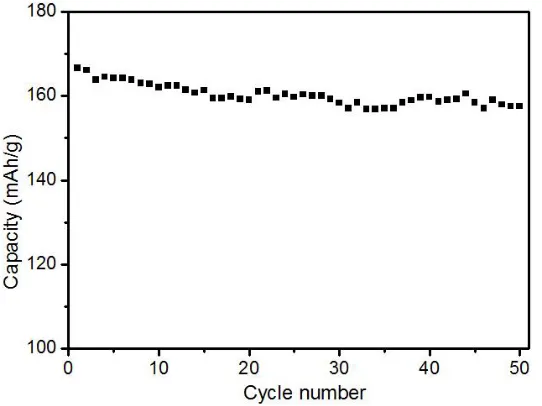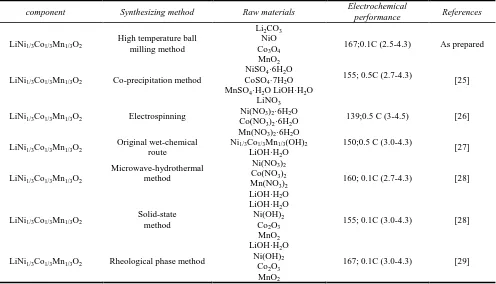Int. J. Electrochem. Sci., 12 (2017) 7166 – 7173, doi: 10.20964/2017.08.42
International Journal of
ELECTROCHEMICAL
SCIENCE
www.electrochemsci.org
Short Communication
Effects of Sintering Time on the Performance of
LiNi
1/3Co
1/3Mn
1/3O
2Synthesized by High Temperature Ball
Milling Method
Ming Tian1, Xuetian Li1, Zhongbao Shao2,*, Fengman Shen1
1
School of Metallurgy, Northeastern University, Shenyang 110819, PR China 2
College of Science, Northeastern University, Shenyang 110819, PR China *
E-mail: shaozhongbao@mail.neu.edu.cn
Received: 2 May 2017 / Accepted: 11 June 2017 / Published: 12 July 2017
Composite material LiNi1/3Co1/3Mn1/3O2 cathode material for lithium-ion battery was obtained with lithium carbonate, nickel (Ⅱ) oxide, cobalt (II, III) oxide and manganese dioxide as raw materials by high temperature ball milling method. To synthesis the LiNi1/3Co1/3Mn1/3O2 with excellent electrical properties, influence of ball-milling time was analyzed in this paper. Results showed that the best electrochemical performance of LiNi1/3Co1/3Mn1/3O2 was obtained from the test, LiNi1/3Co1/3Mn1/3O2 particles acquired ball-milling temperature at 750℃ for 15h, and got performance uniformity of the material. Its initial discharge specific capacity reached 166.6 mAh/g at 0.1 C. The capacity of LiNi1/3Co1/3Mn1/3O2 sample was 157.5 mAh/g, with a capacity retention rate of 94.5% over 50 cycles.
Keywords: Composite materials; LiNi1/3Co1/3Mn1/3O2; High temperature ball milling method; Electrical properties; Ball-milling time
1. INTRODUCTION
The three-element cathode material Lithium titan ate is generally synthesized by co-precipitation method [9-11], solid phase method [12-14], sol-gel method [15-17], microemulsion method [18], microwave method [19], spray drying [20] and combustion method [21]. The traditional high temperature solid-state synthesis method and liquid phase synthesis methods need extremely long synthesis time and a high-temperature calculation, and the latter needs a complex operation, organic reagents and a sophisticated apparatus. Recently, high-temperature ball milling method was reported. It applies to the ball-milling and sintering steps throughout the synthesis process, and was performed on a patented high-temperature mill. The equipment was modified from a traditional mechanical ball-mill by adding a controllable heating device. Therefore, ball-ball-milling and high-temperature heating occurs simultaneously throughout the process [22-24].
In this paper, LiNi1/3Co1/3Mn1/3O2 particles were manufactured from Li2CO3, NiO, Co3O4 and MnO2 by high temperature ball milling method. Aiming at the preparation of LiNi1/3Co1/3Mn1/3O2 particles with good electrochemical performance, LiNi1/3Co1/3Mn1/3O2 particles in different ball-milling time were synthesized by the high temperature ball milling method in order to investigate the effect of ball-milling time.
2. EXPERIMENTAL
[image:2.596.149.445.533.664.2]Stoichiometric amounts of Li2CO3, NiO, Co3O4 and MnO2 with Li: Ni: Co: Mn molar ratio of about 3.09:1:1:1 were dissolved in deionized water, they were then stirred by the stirrer. After stirring for two hours, they were oven-dried at 130℃. After the oven-dried processing, we obtained precursor particles. Then we put the precursor in the high temperature ball milling equipment (illustrated in Fig. 1) at a ball: weight ratio 15:1 [24]and the synthesis process was conducted ball-milling temperatures at 750℃ reaction different time (9, 12, 15 and 18h), the process was conducted under an air atmosphere. Then the powders were obtained.
The structure of the particle was characterized by Rigaku D/max-RB diffractometer type X-ray diffraction (XRD). The morphology and microstructure of LiNi1/3Co1/3Mn1/3O2 powders were characterized by Scanning electron microscopy (SEM HITACHI S-3000H).
The electrochemical properties of LiNi1/3Co1/3Mn1/3O2 powders were investigated using CR2032 cell, which lithium metal as the counter electrode. The separator was a porous polypropylene membrane (Celgard 2400). 1M LiPF6 in a mixture of ethylene carbonate (EC) and dimethyl carbonate (DMC) (1:1 in volume) were used as liquid electrolyte. LiNi1/3Co1/3Mn1/3O2 powder (80wt %), acetylene black (10wt %), and polyvinylidene fluoride (PVDF) (10wt %) were weighted and mixed followed by adding some N-methyl pyrrolidone (NMP), then electrode slurry was obtained. The electrode slurry was coated on an aluminum foil and then was roasted at 120℃ for 12 h. The cells were assembled in a glove box. The cycle charge-discharge test for button battery product at 0.1C-rate was conducted by Neware testing system from 2.5 to 4.3V at the room temperature (the current of 1 C equals to 200mA/g).
3. RESULTS AND DISCUSSION
[image:3.596.171.422.483.645.2]The effects of ball-milling time on the crystal growth of LiNi1/3Co1/3Mn1/3O2 in the synthesis process were investigated. Fig. 2 shows the XRD patterns of LiNi1/3Co1/3Mn1/3O2 particles. The samples of LiNi1/3Co1/3Mn1/3O2 were synthesized ball-milling temperature at 750℃ for 9, 12, 15 and 18h, respectively. All diffraction peaks of the samples in XRD patterns clearly show a single phase formation of an α-layered structure without any impurity phase, the crystallinity of LiNi1/3Co1/3Mn1/3O2 samples has minor increase with ball-milling time prolonging.
Figure 2. XRD patterns of LiNi1/3Co1/3Mn1/3O2 particles obtained with different ball-milling time
1μm in diameter and 3μm in length. However, the LiNi1/3Co1/3Mn1/3O2 particles obtained in 15h were spherical shaped and homogeneously distributed, and the size of the particles were about 2 μm in diameter and 4μm in length. When ball-milling time increased to 18h, the grain sizes of the products notably increased and have the crystal agglomeration.
[image:4.596.143.459.163.441.2]Figure 3. SEM images of LiNi1/3Co1/3Mn1/3O2 particles obtained with different ball-milling time :( a) 9h, (b) 12h, (c) 15h, and (d) 18h
[image:4.596.178.420.511.698.2]
Figure 5. The initial discharge curves at various currents of LiNi1/3Co1/3Mn1/3O2 particles obtained with ball-milling temperature 750℃for 15h
Fig.4 shows the influence of ball-milling time on the specific capacity of LiNi1/3Co1/3Mn1/3O2 between 2.5 and 4.3 V using a low current density of 0.1C-rate at room temperature. The initial discharge capacities of samples are 136.1, 161.8, 166.6 and 148.7mAh/g, respectively. When synthesized ball-milling time was 15 h, the sample has higher capacity than others.
Fig.5 shows the rate performance of the optimized sample of LiNi1/3Co1/3Mn1/3O2 particles obtained with ball-milling temperature 750℃ for 15 h at various currents. At rates of 0.1, 0.2, 0.5, 1.0 and 2.0 C, the initial discharge capacities are 166.6, 158.1, 152.9, 144.9 and 135.3 mAh/g, respectively. The initial discharge capacities of LiNi1/3Co1/3Mn1/3O2 were reduced little with the rise of current. The initial discharge capacity is 135.3 mAh/g at 2.0C-rate. It means LiNi1/3Co1/3Mn1/3O2 which synthesized ball-milling temperature at 750℃ for 15 h has an excellent low rate performance.
[image:5.596.174.428.74.261.2] [image:5.596.164.435.524.727.2]
Figure 7. The Nyquist plots of LiFePO4/C samples obtained with the different synthesis methods
The cycling performance of LiNi1/3Co1/3Mn1/3O2 electrode which synthesized ball-milling temperature at 750℃for 15h was evaluated at the current of 0.1C, and the result is shown in Fig. 6. As shown in Fig.6, the capacity of LiNi1/3Co1/3Mn1/3O2 sample was 157.5 mAh/g, with a capacity retention rate of 94.5% over 50 cycles. It shows an excellent rate cyclic performance.
Table 1. Comparison of LiNi1/3Co1/3Mn1/3O2 powders on their electrochemical properties.
component Synthesizing method Raw materials Electrochemical
performance References
LiNi1/3Co1/3Mn1/3O2
High temperature ball milling method
Li2CO3
NiO Co3O4
MnO2
167;0.1C (2.5-4.3) As prepared
LiNi1/3Co1/3Mn1/3O2 Co-precipitation method
NiSO4·6H2O
CoSO4·7H2O
MnSO4·H2O LiOH·H2O
155; 0.5C (2.7-4.3)
[25]
LiNi1/3Co1/3Mn1/3O2 Electrospinning
LiNO3
Ni(NO3)2·6H2O
Co(NO3)2·6H2O
Mn(NO3)2·6H2O
139;0.5 C (3-4.5) [26]
LiNi1/3Co1/3Mn1/3O2
Original wet-chemical route
Ni1/3Co1/3Mn1/3(OH)2
LiOH·H2O
150;0.5 C (3.0-4.3)
[27]
LiNi1/3Co1/3Mn1/3O2
Microwave-hydrothermal method
Ni(NO3)2
Co(NO3)2
Mn(NO3)2
LiOH·H2O
160; 0.1C (2.7-4.3) [28]
LiNi1/3Co1/3Mn1/3O2
Solid-state method
LiOH·H2O
Ni(OH)2
Co2O3
MnO2
155; 0.1C (3.0-4.3) [28]
LiNi1/3Co1/3Mn1/3O2 Rheological phase method
LiOH·H2O
Ni(OH)2
Co2O3
MnO2
167; 0.1C (3.0-4.3) [29]
[image:6.596.56.552.410.694.2]
The semicircle in the high-middle frequency region relates to charge-transfer resistance for lithium ion reaction at the interface of electrolyte. It is concluded that the LiNi1/3Co1/3Mn1/3O2 sample with synthesized ball-milling time was 15 h exhibits the smallest charge-transfer resistance (200 Ω) than sample with synthesized ball-milling time was 12 h (245 Ω), sample with synthesized ball-milling time was 18 h (251 Ω) and sample with synthesized ball-milling time was 9 h (350 Ω), which indicates that the polarization of sample with synthesized ball-milling time was 15 h is much less than other three samples, it may be beneficial to the rate performance of sample with synthesized ball-milling time was 15 h .
The reasons for this included the following several aspects: The LiNi1/3Co1/3Mn1/3O2 obtained at 15 h with a single phase formation of an α-layered structure without any impurity phase, and particles were spherical shaped and homogeneously distributed, and the sizes of the particles were about 2 μm in diameter and 4μm in length.
LiNi1/3Co1/3Mn1/3O2 powders were synthesized by many research groups and the related electrochemical data were summarized in Tab. 1 under different synthesizing methods. LiNi1/3Co1/3Mn1/3O2 samples made by co-precipitation method [25] with heated at 950℃ for 24h, the initial discharge capacity of the sample obtained was 155 mAh/g at 0.5C-rate (2.7-4.3V). The initial discharge capacity of the sample which obtained by electrospinning method [26] with a complex route was 139 mAh/g at 0.5C-rate (3.0-4.5V). LiNi1/3Co1/3Mn1/3O2 samples via an original wet-chemical route [27] with heat-treated at 500℃ for 6h and then calcined at 900℃ for 12h, the initial discharge capacity of the sample obtained was 150mAh/g at 0.5C-rate (3.0-4.3V). Microwave-hydrothermal method [28] was used to synthesize LiNi1/3Co1/3Mn1/3O2 with a complex route, the initial discharge capacity of the sample was 160 150mAh/g at 0.1C-rate (2.7-4.3V). The initial discharge capacity of the sample obtained which was synthesized by rheological phase method [29] with heated at 800℃ for 20h was 167mAh/g at 0.1C-rate (3.0-4.3V). In this study, LiNi1/3Co1/3Mn1/3O2 particles acquired ball-milling temperature at 750℃ for 15h, and got performance uniformity of the material. Its initial discharge specific capacity reached 166.6 mAh/g at 0.1C-rate (2.7-4.3V). It means LiNi1/3Co1/3Mn1/3O2 which synthesized ball-milling temperature at 750℃ for 15 h has an excellent electrochemical performance.
Compared with LiNi1/3Co1/3Mn1/3O2 powders prepare by other methods, High temperature ball milling method is simple, low-cost and eco-friendly green synthesis approach to synthesize LiNi1/3Co1/3Mn1/3O2. High temperature ball milling method significantly reduced the synthesis temperature and sintering time required in the preparation of LiNi1/3Co1/3Mn1/3O2 by high temperature ball milling method probably because ball-milling happened during sintering. The activation energy of the reaction system can be decreased with an increased reaction power: it significantly enhanced the reaction rate and reduced the synthesis time.
4. CONCLUSION
We investigated the effects of ball-milling time on the performance of the LiNi1/3Co1/3Mn1/3O2. In conclusion, when synthesized temperature at 750℃ for 15 h, of which the initial discharge capacity is 166.6 mAh/g at 0.1C-rate, the capacity was 157.5 mAh/g, with a capacity retention rate of 94.5% over 50 cycles. LiNi1/3Co1/3Mn1/3O2 was synthesized by high temperature ball milling method needs shorter time compared to traditional high temperature solid-state method.
ACKNOWLEDGEMENT
This research did not receive any specific grant from funding agencies in the public, commercial, or not-for-profit sectors.
References
1. T. Ohzuku and Y. Makimura, Chem. Lett., 7 (2001) 642.
2. H. Yoshizawa and T. Ohzuku, J. Power Sources, 174 (2007) 813. 3. J. K. Ngala, N. A. Chernova M. Ma, J. Mater. Chem., 14 (2004) 214. 4. J. Li, J. M. Zheng and Y. Yang, J. Electrochem. Soc., 154 (2007) A427. 5. Y. Zhang, H. Cao and J. Zhang, Solid State Ionics, 177 (2006) 37. 6. P. Yue, Z. Wang and W. Peng, Powder Technol., 214 (2011) 279.
7. Y. Koyama, I. Tanaka, H. Adachi, Y. Makimura and T. Ohzuku, J. Power Sources, 644 (2003) 119.
8. J. J. Liu, W. H. Qiu and G. H. Zhang, J. Power Sources, 174 (2007): 515. 9. Y. Chen, G. Xu, Electrochim. Acta, 87 (2013) 686.
10.R. Zhao, Z. Chen, Y. Zhang, Mater. Lett.,116 (2014) 160. 11.L. Liang, K. Du and W. Lu, J. Alloys Compd., 613 (2014): 296.
12.E. Y. Bang, D. R. Mumm and H. R. Park, Ceram. Int., 38 (2012) 3635. 13.Bang E Y, D. R. Mumm and H. R. Park, Ceram. Int., 38 (2012) 5699. 14.M. Y. Song, H. Rim and H. R. Park, Ceram. Int., 38 (2012) 6591. 15.Y. Zhao, G. Sun and R. Wu, Electrochim. Acta, 96 (2013) 291. 16.T. Zhao, S. Chen and L. Li, J. Power Sources, 228 (2013) 206-213. 17.S. J. Shi, J. P. Tu and Y. Y. Tang, J. Power Sources, 240 (2013) 140. 18.C. Lu and Y. Lin. J. Power Sources, 189 (2009) 40.
19.Q. W. Peng, Z. Y. Tang and L. Q. Zhang, Journal of South China Normal University, 44 (2009) 2147.
20.B. Lin, Z. Y. Wen and Z. H. Gu, J. Power Sources, 175 (2008) 564. 21.M. Y. Song, I. H. Kwon and H. R. Park, Ceram. Int., 38 (2012) 2443. 22.Q. Zhao, Z. B. Shao and C. Liu, J. Alloys Compd., 607 (2014) 118. 23.P. Q. Jia, Z. B. Shao and K. R. Liu, Mater. Lett., 125 (2014) 218. 24.L. Y. Jia, Z. B. Shao and Q. Lü, Ceram. Int., 40 (2014) 739.
25. P. E. Cabelguen, D. Peralta, M. Cugnet and P. Maillet, J. Power Sources, 346 (2017) 13. 26.C. S. Kang and J.T. Son, J. Electroceram., 29 (2012) 235.
27.Q. Su, Y. J Li, L. Li, W. Li, G.L. Cao and L. L. Xue, Mater. Lett., 198 (2017) 180. 28.H. B. Ren, Y. R. Wang, D. C. Li and L.H. Ren, J. Power Sources, 178 (2008) 439. 29.B. J. Shen, J. S. Ma, H. C. Wu and C. H. Lu, Mater. Lett., 62 (2008) 4075.




